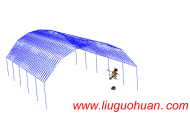共享调谐质量阻尼器(STMD)在附属结构减震中的应用作者: 国巍,李宏男,柳国环 |
||||||
下载次数:
次 更多论文下载...
PDF格式(左键浏览,右键另存):
2009 年 5 月
摘要:鉴于在两个频率接近的临近附属结构之间设置连接粘滞阻尼器(Viscous Damper, VD)的减震效果往往很差,该文采用了一种新型的减震方法:共享调谐质量阻尼器(Shared Tuned Mass Damper, STMD)的方法。该方法在临近的附属结构之间附加公共质量块,并以粘滞阻尼器连接,利用附属结构与质量块之间的相对运动来耗能减震;同时实现了两个附属结构的协调振动,避免地震作用下附属结构碰撞的发生,并且当附属结构频率接近时共享调谐质量阻尼器(STMD)有很好的减震效果。该文研究了在临近附属结构之间分别采用粘滞阻尼器(VD)和共享调谐质量阻尼器(STMD)时的减震效果,并对共享调谐质量阻尼器(STMD)减震效果的适用情况和影响因素进行了分析。 关键词:二次结构体系;附属结构;减震;粘滞阻尼器(VD);共享调谐质量阻尼器(STMD) 中图分类号:TU318 文献标识码:A 文章编号:1000-4750(2009)05-0202-07 Abstract:By considering that the strategy of Viscous Damper (VD) does not behave well in reducing the seismic response of secondary systems, a new strategy termed as Shared Mass Damper (STMD) is introduced in the paper. In the strategy, a shared mass connected by viscous dampers is placed between two adjacent secondary systems, dissipating earthquake energy by the relative displacement between the secondary systems and the shared mass. Meanwhile, two adjacent secondary systems are made to vibrate coordinately so as to avoid the pounding.The new strategy of Shared Mass Damper (STMD) can work well, especially when the frequencies of two secondary systems are close to each other. The effects of two strategies as well as the influencing factors of STMD and VD on reducing the seismic response of secondary systems are studied. Key words:primary-secondary systems; secondary systems; shock absorption; viscous damper (VD); shared mass damper (STMD) 引言 随着社会经济和科学技术的发展,大型电脑信息系统和精密仪器设备越来越频繁的应用使得附属结构的抗震减震设计引起了人们广泛的关注,在地震中它们的损坏所造成的损失往往是巨大的,特别是核电站、发电厂、医院、数据中心等重要生命线工程中,重要的附属结构、设备的损坏还涉及到生命安全、灾后恢复等问题,并可能在相当长的时间内影响建筑物的正常使用,因此附属结构的抗震减震在工程设计中有着重要意义。 在实际工程中,主体结构上往往支撑着多个附属结构,针对多个附属结构系统的特点,可以借鉴临近建筑物之间安装粘滞阻尼器进行消能减震的方法。对于利用临近建筑物之间相对运动来消能减震的方法,国内外进行了很多研究。国内,陈文兵和唐家祥[1]在临近结构体系之间设置了连接构件,并对连接参数进行了优化分析。龚治国等[2]对在上海世贸国际广场主楼和裙房之间设置粘滞阻尼器进行减震的方法进行分析,并评定了其有效性,该方法于2005 年成功应用到实际工程中。徐幼麟等[3―5]对主-从结构体系连接粘滞阻尼器的被动减震方法进行了参数分析。国外,Gurley 等[6]利用连接阻尼器对高耸建筑物在风荷载作用下动力响应进行了耦合减振分析。Luco 和Barros[7―8]采用不同的简化理论模型,对通过粘滞阻尼器连接的临近主体结构体系进行了减振分析。 本文针对多个附属结构体系的特点,首先提出了在两个附属结构之间设置粘滞阻尼器(Viscous Damper, VD)来实现消能减震的方法,这样既可以避免附属结构之间的碰撞,又同时减小了两个附属结构的动力响应。但是,由于该方法在对于频率相近的两个相似附属结构的减震效果很差,基于此,本文借鉴由Abdullah 等[9]在2002 年提出的在临近建筑物之间设置共享调谐质量阻尼器(Shared Tuned Mass Damper,STMD)来减震的方法,将其应用于附属结构之间,并分析了其有效性和在不同参数情况下的减震效果。 结论 针对在相同附属结构之间安装粘滞阻尼器(VD)减震效果不明显的缺点,提出了利用共享调谐质量阻尼器(STMD)来实现多个附属结构协调减震的方法,分析了不同工况下两种方法的减震效果,并研究了STMD 的减震远离和适用情况,得出了一些有意义的结论: (1) 在附属结构之间设置共享调谐质量阻尼器(STMD)和粘滞阻尼器(VD)可以起到很好的减震效果,并可以使临近附属结构协调振动,避免因相互碰撞而发生的损坏。 (2) 当附属结构之间的频率有明显差异时,粘滞阻尼器(VD)可以起到很好的减震效果,当附属结构之间的频率接近时,粘滞阻尼器(VD)的减震效果很差甚至完全失效,而此时共享调谐质量阻尼器(STMD)通过共享质量块调谐共振的动力吸振作用会有很好的减震效果。共享调谐质量阻尼器(STMD)利用的是协调共振效应,可以控制附属结构的某阶振型,与单个粘滞阻尼器相比,更适用于多自由度附属结构的动力控制。 (3) 共享调谐质量阻尼器(STMD)对附属结构频率摄动的鲁棒性较差,随着附属结构频率摄动所导致的频率偏离减震效果大幅减小;对主体结构频率摄动的鲁棒性较强。二次结构体系各部分阻尼比的摄动对共享调谐质量阻尼器(STMD)的减震效果影响不大,鲁棒性强。 (4) 共享调谐质量阻尼器(STMD)减震效果和相应的最优参数对场地条件不敏感。从本文研究可以看到,在白噪声激励下优化的结果对于不同场地类别对应的Cloug-Penzien 随机激励模型也有很好的减震效果,因此场地条件的改变对共享调谐质量阻尼器(STMD)的影响很小。 参考文献(References): [1] 陈文兵, 唐家祥. 联合结构减震体系的动力分析和连接的优化布置[J]. 世界地震工程, 2002, 18(3): 141―145.Chen Wenbing, Tang Jiaxiang. Dynamic analysis of a combined structure vibration-reducing system and linker s optimization layout [J]. World Information on Earthquake Engineering, 2002, 18(3): 141―145. [2] 龚治国, 吕西林, 翁大根. 超高层主楼与裙房黏滞阻尼器连接减振分析研究[J]. 土木工程学报, 2007, 40(9):8―15.Gong Zhiguo, Lu Xilin, Weng Dagen. Analysis of vibration reduction of fluid linking dampers connecting main building with podium [J]. China Civil Engineering Journal, 2007, 40(9): 8―15. (in Chinese) [3] Xu Y L, He Q, Ko J M. Dynamic response of damper-connected adjacent buildings under earthquake excitation [J]. Engineering Structures, 1999, 21: 135―148. [4] Yang Z, Xu Y L, Lu X L. Experimental seismic study of adjacent buildings with fluid dampers [J]. Journal of Structural Engineering, 2003, 129(2): 197―205. [5] Zhu H P, Xu Y L. Optimum parameters of Maxwell model-defined dampers used to link adjacent structures [J]. Journal of Sound and Vibration, 2005, 279(1-2): 253―274. [6] Gurley K, Kareem A, Bergman L A, Johnson E A, Klein R E. Coupling tall buildings for control of response to wind [C]. Proceedings of the Sixth International Conference on Structural Safety and Reliability (ISOSSAR), A.A.Balkema, Rotterdam, 1994: 1553―1560. [7] Luco J E, Barros F D. Optimal damping between two adjacent elastic structures [J]. Earthquake Engineering and Structural Dynamics, 1998, 27: 649―659. [8] Luco J E, Barros F D. Control of the seismic response of a composite tall building modeled by two interconnected shear beams [J]. Earthquake Engineering Structural Dynamics, 1998, 27: 205―223. [9] Abdullah M M, Hanif J H, Richardson A, Sobanjo J.Using of a shared tuned mass damper (STMD) to reduce vibration and pounding in adjacent structures [J].Earthquake Engineering and Structural Dynamics, 2002,30: 1185―1201. [10] Lin J H. A fast CQC algorithm of PSD matrices for random seismic responses [J]. Computers and Structures,1992, 44(3): 683―687. [11] 薛素铎, 王雪生, 曹资. 基于新抗震规范的地震动随机模型参数研究[J]. 土木工程学报, 2003, 36(5): 5―10.Xue Suduo, Wang Xuesheng, Cao Zi. Parameters study on seismic random model based on the new seismic code [J].China Civil Engineering Journal, 2003, 36(5): 5―10. (in Chinese) |
||||||
| welcome to www.liuguohuan.net |
| 天津大学 建筑工程学院 ; 天津大学 前沿技术研究院; 国家重点实验室-水利工程仿真与安全 |







